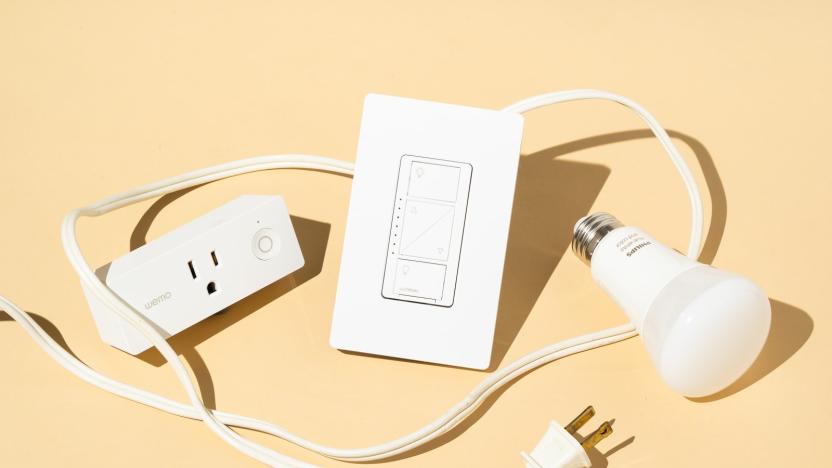iclever
Latest

The best plug-in smart outlet
By Rachel Cericola This post was done in partnership with Wirecutter. When readers choose to buy Wirecutter's independently chosen editorial picks, Wirecutter and Engadget may earn affiliate commission. Read the full guide to plug-in smart outlets. A smart plug can make magic, turning any electronic device into one that can be controlled remotely or put on a schedule. That means you'll never have to enter a dark room or worry that you left the curling iron plugged in. We recommend the Wemo Mini, a reliable Wi-Fi smart plug that works with most major smart-home platforms, including Amazon Alexa, Apple HomeKit, and Google Assistant. The Wemo Mini is the only model that has been rock-solid reliable over long-term use, offers a compact design that won't block both outlets on a wall plate, and supports all the major voice-control platforms. Like most of the smart plug-in switches we tested, the Wemo Mini is easy to set up: Plug it into an outlet, download an app to your phone, make the wireless connection, and then control lamps, small appliances, and even higher-draw devices like fans and air conditioners. The Wemo family also includes light switches and dimmers, so it's easy to expand your system. The Lutron Caséta Smart Lighting Lamp Dimmer costs more than most smart plugs, but it has two outlets, allowing you to control two lamps or strings of lights at once (though not independently). And it lets you dim those lamps rather than just turning them on and off—a rarity among smart plugs. The Caséta system connects over a robust wireless mesh network, rather than Wi-Fi, so Wi-Fi dead spots in your house aren't a problem, but it requires Lutron's proprietary Caséta Smart Bridge hub. We recommend you buy a kit that includes the hub. This outlet supports only lamps, not fans or other motors, but the Caséta line includes compatible in-wall dimmers, window shades, and remotes, so this model is ideal for people who want a larger smart-home system. It works with Amazon Alexa, Apple HomeKit, Google Assistant, Nest, Samsung SmartThings, Wink, and more. The iClever IC-BS06 smart plug can weather the outdoors better than you can, with the best operating temperature (–4 to 140 degrees Fahrenheit) of any model we tested. It has two plugs you can control remotely and independently using the app or voice control (via Amazon Alexa and Google Assistant, but not Siri), and you can configure automations based on time, weather, humidity, temperature, air quality, sunrise and sunset, or triggers from other iClever devices. The TP-Link HS300 is a little pricier than the average smart plug, but it's worth it as it transforms one wall plug into six independently controlled outlets. Of the smart power strips we tested, it also has the most USB ports (three) and the longest power cord. It also supports voice control via Alexa, Google Assistant, Microsoft Cortana, and automations via IFTTT. The lowest priced model on our list is also the smallest—making it possible to fit the Monoprice Stitch Mini into almost any outlet in the house without crowding. It's also the least expensive model we've seen to include energy monitoring. Currently, it supports only Alexa and Google Assistant (and IFTTT unofficially), but you can also set schedules that are triggered by sunrise and sunset and local weather conditions.

When to use a smart bulb, switch or plug
By Rachel Cericola This post was done in partnership with Wirecutter. When readers choose to buy Wirecutter's independently chosen editorial picks, Wirecutter and Engadget may earn affiliate commission. Read the full blog seeing the light: when to use a smart bulb, switch, or plug. I'm not sure if it's because I've captured a lot of critters on home security cameras or seen one too many horror movies, but entering a dark house terrifies me. Although my husband would be perfectly happy to solve this problem by leaving the lights on all day and night, it's completely unnecessary: Smart lighting exists for precisely this purpose. Setting up your home with smart lights can solve a lot of problems. However, because there are several types of devices you can pick from—bulbs, light switches, and add-on plugs—it can be hard to know where to start. Why and when do you pick one of those devices over another? All smart lighting devices allow you to control them from your smartphone, and you can set them up to work like old-fashioned lighting timers, but they can do much more. You can control whole groups of lights at once, set them to go on and off based on local sunset times, and configure them to respond to other smart devices, such as motion sensors or security cameras. But each type of device has a superpower (and also a weakness, just like Superman). Let's look at what devices work best for three different scenarios.